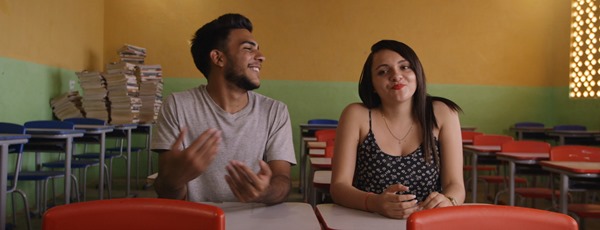In 2012, Jack Andraka earned the top prize at the world’s largest science-themed event for high school students, the International Science and Engineering Fair (ISEF). The present-day Andraka looks back and comments on that fateful day, recalling the thrill he felt at being called onto the stage. The highly emotional prologue proves fitting for what follows, as directors Cristina Costantini and Darren Foster’s documentary profiles a cross section of brilliant youths from around the world, all of whom aspire to follow in the footsteps of Andraka and others by winning big at the 2017 ISEF.
Some of the prospective competitors include kids from Louisville’s duPont Manual High School, considered to be the best school for the sciences in Kentucky: 13-year-old Anjali, an ultra-competitive child prodigy; as well as a team that features seeming opposites in Ryan, a programming ace who resembles the prototypical surfer dude, and Harsha, an aspiring engineer who is comparatively more buttoned-down. Anjali has developed a sensor for detecting arsenic in drinking water, while the guys are working on a network-enabled stethoscope platform non-doctors would be able to use to make diagnoses.
At a regional qualifier, the three are among a large cohort of duPont Manual students competing for a few slots at the ISEF finale, and in order to succeed, they must explain their projects briefly and compellingly to the judges. After we’ve gotten our first taste of the kind of stressful situations that the subjects will face, the canvas expands dramatically to geographically diverse places, not all of which seem conducive to scientific research. The moral appears to be that no matter where you are from, you can come up with a potentially world-changing idea.
However, in profiling the various youths, who hail from a scenic German town beside the Rhine to a New York City suburb, what also becomes clear is all have their own obstacles to overcome. The most compelling personal stories include those of Kashfia, a child of Bangladeshi immigrants who simultaneously sticks out and gets largely ignored at a mostly white public high school in South Dakota. Here there are plenty of resources allotted to the winless football team but none to a laboratory. But at the same time, if it weren’t for sports, Kashfia, whose project involves studying brainwave activity, might not have found a supportive mentor in the football coach.
Meanwhile, Myllena and Gabriel, who come from a small town in Brazil where many residents still engage in farming, are arguably the most impressive among the young scientists. In 2015, as their community was gripped by the Zika virus outbreak, they pinpointed the protein capable of stopping the disease’s growth. That, in turn, catapulted them into their country’s national scientific competition and a shot at the ISEF finale. Despite their obvious brilliance, the film goes out of its way to paint these two as the biggest longshots to win it all, from showing their extremely modest backgrounds to raising the question of whether their speaking only Portuguese will hinder their ability to explain their research to the judges.
Interestingly, one of the most memorable characters isn’t a student at all but Dr. Serena McCalla, a teacher who has turned Jericho High School of Long Island, New York, into a perennial scientific powerhouse. Her methods involve a lot of tough love, but there is no denying the results—Jericho regularly sends multiple finalists to compete for ISEF’s top awards. McCalla proves an inspiring figure, pouring much of her own passion and energy into pushing her students to maximize their potential. The vast majority of them are from other countries, and McCalla, who is a second-generation immigrant herself, points to foreign-born talent as having been integral to the United States’ technological and economic success throughout its history. This ties into an overarching theme, that the country no longer values either the sciences or immigrants as strongly as it once did.
Eventually, the finalists all arrive in Los Angeles, where the ISEF finale will take place, and break the ice via a mixer, a sequence that briefly reminds us that for all of their smarts, they are also goofy teenagers. They simultaneously express excitement and trepidation over meeting people their own age, and then they dance—badly, for the most part. Then the film starts counting down the time between setup and when judging begins, and the kids are back under fire. They face possible infractions that could disqualify them after all their hard work, and these scenes are understandably tense.
The film does a very good job of building suspense, but it occasionally focuses more on the human drama than on the scientific details. In the case of Myllena and Gabriel, I wanted to know so much more about the research and experimentation that got them to their breakthrough. Similarly, we get to know the Jericho students through Dr. McCalla but not as individuals. We don’t even find out their respective projects, which makes one climactic moment highly frustrating.
Nevertheless, the film leaves us with a sense that the sciences have the power to change people’s lives and to bring folks from different walks of life together. Meanwhile, the filmmakers deserve credit for their handpicking of their subjects. Out of the estimated 1,700 kids worldwide who competed at their respective regionals, Costantini and Foster managed to identify a few who ended up going quite far. If there were an award for talent searches, they would certainly deserve a prize.







Leave A Comment